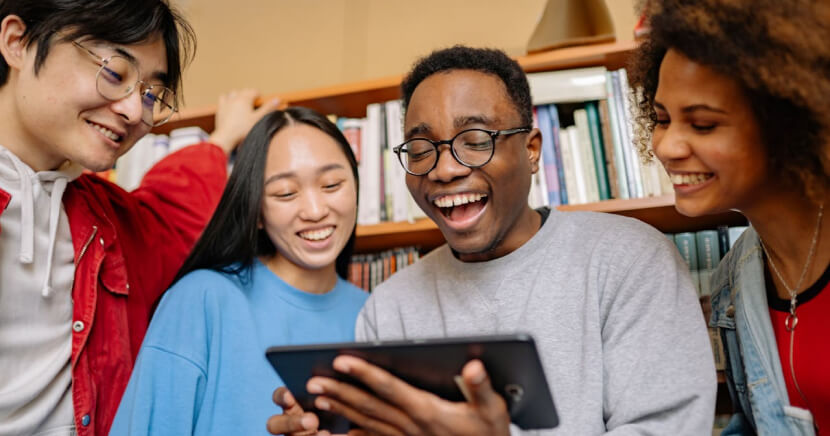As part of National Library Week, the American Library Association released its annual State of America's Libraries Report on April 8.
The report doesn't gloss over the fact that 2023 was a difficult year for many libraries, especially in light of a record number of book challenges. In her introduction, however, ALA president Emily Drabinski reminds us that librarians serve a higher purpose, and that for community members of all walks of life, libraries matter:
As we continue to work together toward the better world we all know is possible, let’s remember that we are all in this together. Across party lines and across the political spectrum, the vast majority of people love their libraries for the ordinary and extraordinary work we do each day: connecting people to reading and resources, building businesses and communities, expanding literacy across the lifespan, and making great Saturday afternoons.
With that in mind, let's take a look at eight reasons why libraries — not just the local public library, but school and academic libraries too — still matter to the communities they serve.
See also:
-
National Library Week highlights the role of libraries in our digital age
-
Unlocking potential: utilizing library space for community engagement and recreation
1. Access to information

One thing that makes libraries essential is that they provide free access to a wide range of information resources, including books, databases and digital platforms such as PressReader, which features thousands of newspapers and magazines from around the world. This is particularly important for community members who may not have internet access or cannot afford to purchase books or other resources.
As the ALA reports, two U.S. lawmakers consider the countless resources offered by school libraries in particular to be of such great importance as to warrant legal protection. In 2023, Sen. Jack Reed (D-RI) and Rep. Raúl Grijalva (D-AZ-03) reintroduced the Right to Read Act in the Senate and House of Representatives respectively.
If passed into law, this bill would ensure every student has access to an effective school library staffed
by a certified school librarian and provide a vital infusion of funding for school libraries.
2. Promotion of literacy
Libraries play a vital role in promoting literacy and a love for reading. They offer programs and resources for children, adults, and families to improve literacy skills and encourage lifelong learning.
Literacy rates are important for anyone interested in getting an education or generally participating in society — not to mention enjoying a good novel — the ability to read is also intrinsically tied to economic development.
Literacy rate (in particular, early literacy) and mean education level are both indicators of economic development. Elevated levels of early literacy improve the quality of child care and academic success. Literacy makes a significant difference later in life too by contributing to a greater workforce participation level.
3. Community hub
The local library serves as a community hub where people can gather, interact and engage in various activities. They host events, workshops, book clubs, lectures, and other programs that bring people together and foster a sense of belonging and community.
In recent years, few people have been as vocal in their support for public libraries as Eric Klinenberg.
The Helen Gould Shepard Professor in the Social Sciences and director of the Institute for Public Knowledge at New York University, Klinenberg is also the author of Palaces for the People, in which he advocates passionately for social infrastructure as a means to fight inequality, polarization and the decline of civic life.
In his book, Klinenberg reports on the important role that schools, parks, playgrounds, athletic fields, churches, community centers and barbershops play in keeping citizens engaged. He says it's the public library, however, that has the greatest potential for connecting people.
In an article he wrote for his publisher's website, Klinenberg noted the following:
During my research, I learned that libraries are not only important for providing books, films, internet access, and other vital information, but also for ensuring a neighborhood’s vitality and promoting stronger social ties. Palaces for the People—a term I borrow from Andrew Carnegie, the great sponsor and champion of libraries around the world—reports on all kinds of surprising programs one finds in modern libraries: virtual bowling leagues for older people who might otherwise stay home alone; early literacy programs for bilingual children and families that can’t afford books; karaoke sessions where children with disabilities sing along with elders who are looking for meaningful daily activities; morning tea-times for unemployed men who are striving to find dignity and respect.
4. Digital inclusion

One of the vital roles that public libraries play is in bridging the digital divide, which refers to the gap between those who have access to technology (including broadband internet connectivity) and those who do not.
In 2021, United Nations Deputy Secretary-General Amina Mohammed warned the UN General Assembly, “As the world becomes more digitally dependent, it threatens to exclude those that remain disconnected. Almost half the world’s population, 3.7 billion people, the majority of them women, and most in developing countries, are still offline.”
Even in more developed countries such as the U.S. and Canada, this digital divide persists, particularly for low-income individuals, seniors and residents of rural communities. Fortunately, by offering a range of digital devices and services, local libraries can help visitors access tech tools, improve their digital literacy and computer skills, get on the web and learn to navigate the internet safely.
5. Preservation of culture and history
One way academic and public libraries serve their communities is by preserving cultural heritage and historical materials for future generations. They collect, catalog and maintain rare books, manuscripts, archives and other valuable resources that contribute to our understanding of the past and enrich our cultural heritage.
For libraries in many communities, as we noted in a recent blog post, a commitment to preserving and promoting Indigenous languages is part of an overall mission to reflect and represent the diverse nature of the patrons they serve.
6. Support for education
According to the American Library Association website, "As champions of lifelong learning, libraries are a place to quench curiosity, access technology and explore new ideas, hobbies and careers."
Libraries support formal education by providing resources, research assistance and study spaces for students of all ages. Some branches may also offer tutoring, homework help and educational programs to supplement classroom learning.
7. Equity and inclusion

Libraries promote equity and inclusivity by offering resources and services that are accessible to everyone, regardless of socioeconomic status, age, ethnicity or ability. They strive to create welcoming and inclusive environments where all members of the community feel valued and respected.
According to the ALA's State of American Libraries Report, Penn State University Libraries launched three sensory rooms at its Berks, Brandywine, and University Park campuses in 2023 to support student wellness and belonging through the libraries’ LibWell initiative:
The rooms are designed to provide a safe, inviting space for neurodivergent students who may struggle in traditional study spaces. They are equipped with noise-reducing chairs, specialized lighting, yoga mats, weighted lap blankets, and other features to help reduce stress and anxiety. These sensory-sensitive elements are particularly helpful for students with autism, attention-deficit/hyperactivity disorder, dyslexia, and post-traumatic stress disorder.
8. Information and media literacy
Libraries play a crucial role in promoting information literacy by teaching people how to find, evaluate, and use information effectively and ethically. They offer instruction and support in research skills, critical thinking, media literacy and digital literacy, empowering individuals to navigate an increasingly complex information landscape.
We tend to think of media literacy as a set of skills that are crucial for children and young adults as they grow up in a media-saturated world. It turns out, however, that older generations are also at risk.
If they lack the techniques necessary to spot misinformation online, as McAfee points out, “Older adults can easily fall prey to scams, conspiracies, hoaxes, and false news stories online.” McAfee cites a 2019 study out of Princeton and NYU, which found that, prior to the 2016 election, Americans over 65 were seven times more likely than those under 29 to post articles from fake news domains.
As the New York Times notes, “in a digital age, media literacy also includes understanding how websites profit from fictional news, how algorithms and bots work, and how to scrutinize suspicious websites that mimic real news outlets.”
The bottom line is that people of all ages could use some help learning techniques to identify so-called “fake news”. Librarians can help stem the tide of online disinformation by including instruction in information and media literacy in their digital-skills programming.
It's just one more way that, more than ever, libraries still matter.









